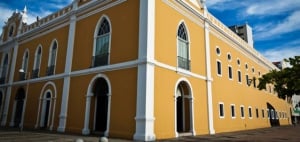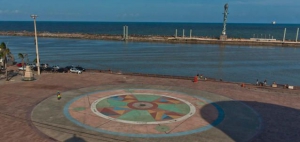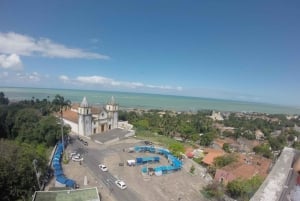Recife Old Town
Recife Old Town (Recife Antigo) is where the city was founded in 1537 due to its excellent natural port shielded from the South Atlantic ocean by high natural reefs, through which its economy flourished up to the 19th Century.
The historical rivalry between neighbouring Olinda stems from Recife taking the status as capital of Pernambuco State in 1837 through its economic development and its strategic trading position.
Recife Old Town is one of the most pedestrian friendly areas in the city, which makes it possible for visitors to go to all must-see places in a single, pleasant stroll. The site currently displays a unique blend of culture, history and entertainment which makes it a remarkable part of town — particularly during Carnival.
Redevelopment of the quayside area
Around the Marco Zero square, all the old warehouses and many iconic historical buildings are being renovated.
Next to the square, a new art and crafts centre was opened in 2012 which has opened up the river front for pedestrians with a restaurant and bar.
Further towards the opening of the harbour to the sea is the new Cruise passenger terminal.
By 2014, further attractions for visitors will be opened including a museum celebrating the regional music genre forro.
Marco Zero
On the original island of Recife is the point which marks its foundation, called Marco Zero (Zero Point), which is a large open area looking out onto the mouth of Capibaribe river and the Atlantic over the reefs, upon which is Recife's Millenium sculpture park by the famous local sculpter Francisco Brennand. The sculpture park can be accessed by a short boat trip from Marco Zero square or a car or taxi through Brasilia Teimosa district if your driver knows the way.
Next to the Marco Zero square is the recently-opened Pernambuco Artcraft Center (Centro de Artesanato de Pernambuco), where visitors can find prime examples of regional artcraft for sale, from chef d'oeuvres by renowned artists to clothing and textile —even handmade toys.
By 2014, further attractions for visitors will be opened in Marco Zero quay area, including a museum celebrating the regional music genre forró. Further towards the opening of the harbour to the sea is the new Cruise passenger terminal.
Just over the road there are several important cultural venues housed in beautifully restored historical buildings: Centro Cultural dos Correios, Caixa Cultural and Espaço Cultural Santander, which host exhibits, shows and events throughout the year.
Also, the bookstore Livraria Cultura regularly holds lectures, concerts and other relevant events for the town's cultural life. This massive bookstore stands right next to Paço Alfândega, a shopping mall unique for its architectural elegance. The building dates back to 1732, having served through the years as convent, customs outpost and warehouse. After careful restoration, it now has elegant stores, art galleries and restaurants with a striking view over the Capibaribe River.
Just outside Paço Alfândega, you'll also find an assortment of bars and restaurants which attract the bohemian population of the town, particularly on Rua da Moeda.
Bom Jesus (Good Jesus) Street
Just behind Marco Zero square is Bom Jesus Street, previously known as Rua dos Judeus (the Jewish Road). This address gained its name for having "Kahal Zur Israel", the oldest Jewish synagogue built in the Americas (North and South), constructed during the Dutch occupation of Recife (1630-1657), but abandoned shortly after with the return of the Portuguese. Visitors can go inside the restored synagogue, which works as a museum, and rediscover this part of Recife's multicultural legacy. There is well documented evidence that shows that some of the Jews who left Recife went on to found a new community in New Holland, which is now no less than New York city.
The Bom Jesus Street also receives every Sunday a street fair for handcraft, souvenirs and other unique articles which make it even more delightful to spend an afternoon in this area. Restaurants and bars add up to this.
Further down, a high building stands out from the other two, three stories houses of the area. It is the Torre Malakoff, a tower built in 1855 and that has served as a lighthouse and astronomic observatory and currently is a space for cultural exhibits and displays. The view from the top is one of the most amazing ones in this area.
















